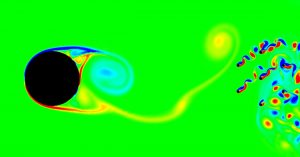 FSI Seminar on Thursday 10th December in 176/L1107,
FSI Seminar on Thursday 10th December in 176/L1107,
Boldrewood Innovation Campus
to be given by Christian Klettner, Research associate, Mechanical Engineering, University College London
Risers from the sea floor to installations at the sea surface are an integral part of the flow assurance of deep sea oil exploration, which has become necessary in the last decade. These risers are subjected to various hydrodynamic forcing, particularly sea currents, wakes of upstream installation members and surface waves, which can result in vortex or wake induced vibrations and these in turn can result in riser fatigue or collision. The free stream flow past groups of cylinders has been studied for two- and three-dimensions for Re=100(based on the cylinder diameter) by Nicolle & Eames (2011) (direct numerical simulations) and ReO(10000) by Chang \& Constantinescu (2015) (large eddy simulations) respectively. In this study we will be focusing on the first two aspects listed above, numerical simulations will be performed to investigate the effect of an upstream truss on an array of cylinders. The main diagnostic will be how varying the void fraction of the array of cylinders affects the frequency and magnitude of the drag and lift forces on the cylinders.
Brief CV
Christian Klettner received his BEng in 2006 and PhD in 2010 from University College London. His PhD, under the supervision of Ian Eames, was on aspects of solitary waves propagating over different topography using numerical simulations. He was in at National University Hospital Singapore as a post doc for 2.5 years developing numerical models and performing small scale experiments on transport in hospital rooms. He is now a post doc at UCL Department of Mechanical Engineering working on the project URBANWAVES which is in collaboration with UCL Civil Engineering Department. The project will investigate the forces exerted on coastal installations during tsunami and storm surge inundation which will require the development of various numerical methods. The intention is to calibrate a shallow water model with large scale numerical simulations of the flow past a building with varying blockage ratio. These can then be incorporated into city wide shallow water models.
